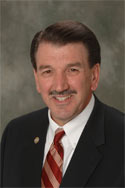BENTON–There are things that happen in life, even though hard to explain, that can be passed off as coincidence. And then there are other things, regardless of how much a person tries to reason, that simply have no explanation. Such was the case recently in Benton when a simple phone call produced a chain of events that could only be described as eerie.
The odyssey began Thursday when Benton High School athletic director Don Smith contacted Benton businessman David Severin looking for 40 small flags to place at Tabor Field for Friday night’s football game.
Severin explained to Smith that he also had been trying to locate flags for his store, All Stars n’ Stitches, that’s located on the Benton square. Severin told Smith, in the aftermath of what had taken place in New York City and Washington D.C., everybody was sold out of flags.
Approximately 30 minutes after the phone call Severin received another call, this time from his mother.
“The first thing she asked me was if I knew anybody that might be looking for some flags,” Severin said. “I asked her how many flags she had and she said 40.”
Severin explained that his mother had been going through the personal belongings of his father, the Rev. George Severin, who passed away two months ago, and came upon the flags that had never been unwrapped.
Severin immediately traveled to his mother’s home and what he saw, in his words, gave him “goose bumps.”
“My dad loved to decorate with flags so it wasn’t uncommon that he’d ordered them,” Severin said. “But when I looked at the sales ticket I noticed that he had ordered the flags more than 30 years ago.”
The flags were shipped, Severin said, from New York City on Sept. 11, 1970 – exactly 31 years to the day that New York City was attacked by terrorists.
“Totally unbelievable,” Severin said. “When I saw the date and where the flags were shipped from … I couldn’t believe it – what’s the chances?”
And if that’s not enough for any skeptics in the audience who want to say ‘merely a coincidence’ there’s one final piece to this puzzle.
According to the sales ticket the flags were shipped to the house where the Rev. George Severin lived in 1970 – the address was 337 South Main Street in Benton — which happens to be the same house where Don Smith, the person that made the original phone call about the flags, currently lives.


